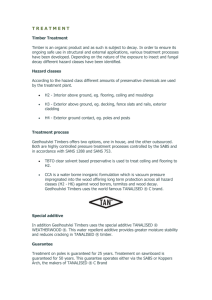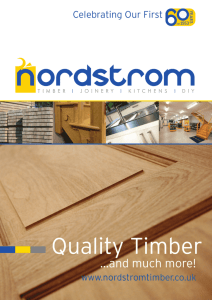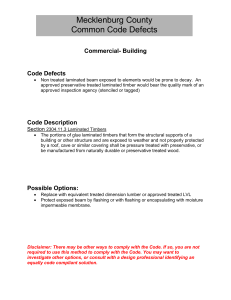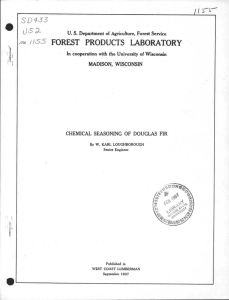T TESTM-STM. - FOREST SERVIC E
advertisement
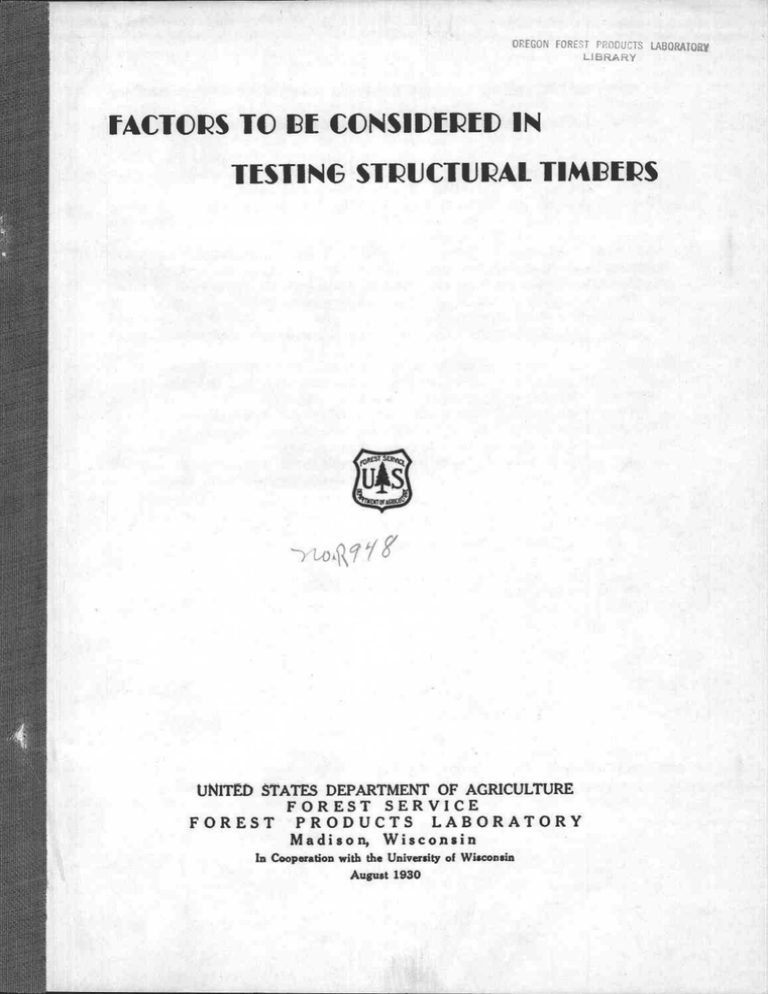
OREGON FOREST PRODUCTS LABORATOR Y LIBRARY T TESTM-STM. ii - UNITED STATES DEPARTMENT OF AGRICULTUR E FOREST FOREST SERVIC E PRODUCTS LABORATOR Y Madison, Wisconsi n In Cooperation with the University of Wisconsi n August 1930 OREGON FOREST PRODUCTS LIBRAR Y LABORATORY FCTORS TO BE CONSIDERED IN TESTING STRUCTURAL TIKBERS l By J . A . NEI7LIN, in Charg e Section of Timber Mechanic s Too much emphasis cannot be placed ot the importance o f standard procedure in making strength tests on structural timbers . This article enumerates the more important factors that should b e considered in any series of tests on structural timbers whether ne w or old with the hope that future tests will be conducted according t o standard procedure, so as to obtain results that can be compared wit h those of other investigators without danger of arriving at totall y unjustifiable conclusions . The need for standard procedure is fully demonstrated by the lack of uniformity in early as well as more recen t tests made on structural timbers by various investigators in th e United States . In recent years several series of tests have bee n made on structural timbers that have been removed from old building s and bridges in the process of rebuilding . The diversified method s used in testing and the lack of appreciation of the effect of a number of factors of importance has resulted in data of questionable value . The standard procedure? noir followed and advocated by th e Forest Products Laboratory, U . S . Department of Agriculture, Fores t Service, in testing large structural timbers has been essentially th e same for the past 25 years . This method calls for third-point loading, which consists in loading the beam at two points one-third th e span length from each support . The beams are usually tested over a 15-foot span . The center loading method, which has been used by some investigators, results in giving less influence to injurious defects , such as knots and cross grain, and does not bring horizontal shea r into play, as does the third-point loading method, which approximate s more nearly practical loading conditions . For this reason, strengt h tests made by the center loading method give considerably higher results than by the third-point method . The effect of defects, such as knots and cross grain, o n strength has been fairly well established and recognized in the basi c 1 -Published in The Timberman, August 1930 . ?Standard Methods of Conducting Static Tests of Timbers in Structura l Sizes, American Society for Testing Materials, Standards for 1927 , Part II, p . 661+ . R948 grading rules and working stresses advocated by the Forest Product s Laboratory, the American Railway Engineering Association, and th e American Society for Testing Piiaterials . Fully as important as the actual presence of the defects themselves is their size, number, an d location in the piece . Obviously, defects will have their greates t effect when at points of maximum stress . In a beam tested under center loading, the maximum stress in bending occurs at the center . Defect s would have their maximum effect at the center of the length on th e bottom face and also on the lower edges of the vertical faces of th e beam . If the defects were located toward the neutral axis and towar d the ends, their effect would diminish . Under third-point load, defect s would have the maximum effect in the lower surface and edges anywher e between the loads . It is evident that with center loading the full influence of defects within the middle third of a beam is not obtained . Careful attention must also be given to such factors a s speed of test and kind of bearings at supports and load points . Tests have shown that multiplying or dividing the rate of applicatio n of the load by 10 raises or lowers the strength by approximately 1 0 percent . The bearings at the load points require special attentio n in order to prevent premature compression failure both along an d across the grain . This is taken care of in the standard procedur e by distributing the load through special bearing plates and curve d blocks, In the case of center loading, the standard bearings resul t in a calculated bending moment that is higher than the moment actuall y developed . with third-point loading the calculated moment is develope d in the central portion of the beam in spite of the distributing effec t of the load blocks . Size is another important consideration in tests of structural timbers . The smaller the timber the higher the stresses developed and the less the influence of seasoning checks . Consequently , it is evident that in order to obtain a true measure of the effect o f seasoning checks and of the magnitude of stresses developed in structural timbers in service, it is necessary to adhere largely to a single size of timber for comparison . It is, of course, well known that the moisture content o f wood has a tremendous effect on the strength of small clear pieces . In structural sizes, however, the development of defects tends t o offset any increase in fiber strength that may take place as a resul t of a reduction in moisture content . Furthermore, structural timbers , even after air seasoning for 1 to 2 years, are only partially dry . The outer shell may be somewhat near an air .-dry condition, but the moisture content increases from this point to a practically gree n condition at the center . This unequal distribution of moisture conten t in most species used for structural timbers causes a progressiv e failure and appears to be one of the large factors that prevent so called air-dry timbers from showing any higher strength than gree n R948 -2- timbers . After many years of seasoning, structural timbers wil l assume a more nearly uniform moisture content throughout, and, wit h the exception of additional weakening due to defects, whose effec t may be largely missed in testing with center loading, would be expected to increase in strength much as do small clear pieces . The impression should not be gained that standard procedur e alone is a panacea for all ills in timber testing . As a general rule , any series of tests to determine the influence of such factors a s age, preservative treatments, and seasoning require similar tests o f control specimens, either full sized or small clear, as a basis fo r comparison . Furthermore, since all grading rules take into accoun t certain practical conditions which do not give careful consideratio n to such factors as density, exact size of timber, and exact size an d location of defects, to merely grade the timbers proves relativel y ineffective from the standpoint of careful analysis of the data . In other words, it is highly essential that none of the de tails, such as average moisture content, moisture distribution, an d size, number, and location of defects, referred to in the America n Society for Testing i.Iaterials Standards be overlooked or slighted i n any way if results of any significant value are to be obtained . Careful analysis should also be made of the data to see that none of th e factors that affect the strength of structural timbers have bee n overlooked or misinterpreted .
